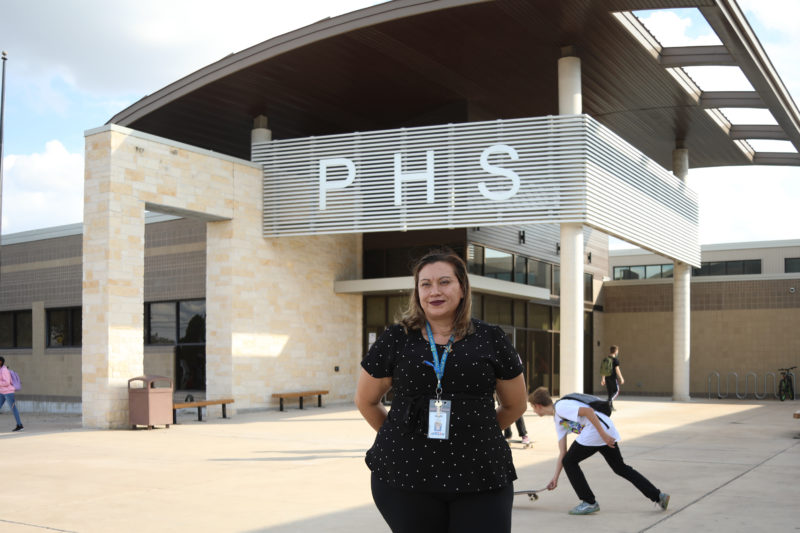Central Texas School Social Workers and Counselors Face Pandemic-related Challenges
By Benton Graham and Jillian Price
Reporting Texas

Ana Bowie, a Pflugerville High School social worker, stands outside the school on October 20, 2020. Pflugerville High School is using a hybrid teaching model, with 25% of the students attending classes in person and 75% attending online. Chloe Bertrand/Reporting Texas
On a Friday morning in September, Ana Bowie’s supervisor walked into her office at Pflugerville High School and told her the news — a 10th grade student had just committed suicide. Bowie, a 48-year-old school social worker, immediately set up an emergency faculty meeting for later that morning.
The news hit the faculty hard. Teachers reflected on the student’s quirky attitude, good humor and musical prowess. That night, Bowie’s thoughts turned to the student’s family.
“It was hard to sleep thinking about all the things that his family and friends were going through,” Bowie said.
Since the pandemic forced schools to limit in-person classes, social workers and counselors have struggled to maintain relationships with students. In addition to the difficulty of staying in touch with students virtually, social workers have had to navigate what experts call a mental health crisis. Social isolation, increased screen time and pandemic-related stress have combined to make the perfect storm for students dealing with mental health challenges.
While counselors tend to focus narrowly on specific mental health issues and social workers on a broad set of services, the two careers overlap in their dedication to the emotional well-being of their students.
Some students have embraced remote learning, Bowie said, but others have struggled with the inability to socialize with their peers at school. Students who live in households with stressful family dynamics now lack the reprieve offered by in-person school, and parents recognize the increased toll stress is taking on their children, Bowie added.
In June, more than two-thirds of parents said their children’s mental health was worse or on track to be worse than when the pandemic began, according to a Gallup poll.
Finding the balance between ensuring children have access to mental health services and keeping social workers safe is important, said Will Francis, executive director of the National Association of Social Workers’ Texas chapter.
“If a child is in school, they can just pop into a social worker’s office,” Francis said. With most students still virtual, that option doesn’t exist.
School social workers were already stretched thin prior to the pandemic. Texas employs a little over 1,000 school social workers, he added. There are 5.5 million public school students in Texas.
In the 2019-2020 school year, Texas public schools had a ratio of 412 students per counselor. The American School Counselors Association recommends one counselor per 250 students.
As school administrators began planning for this school year, the National Association of Social Workers’ Texas chapter sent a letter to the Texas Education Agency spelling out the unique role school social workers play during the health crisis, Francis said.
“School social workers have extensive training in trauma-sensitive approaches, crisis intervention, and public health concerns, which makes them highly qualified in addressing the needs of students during the reintegration process to traditional schooling,” the letter read.
When asked how the Texas Education Agency is supporting school social workers during the pandemic, Jacob Kobersky, a spokesperson for the agency, pointed to the Texas Education Agency website, which outlines how social workers can provide services remotely.
The opportunity to work directly with students attracted Katie Lewin, 37, to social work. Lewin began working as an elementary school social worker in the Manor Independent School District, in February. As the pandemic progressed, her role expanded from tending to the students’ emotional needs — which she said has become more difficult because of fewer face-to-face interactions — to connecting families with basic needs like food and housing support.
Lewin has increased the number of visits she makes to students’ homes. “Everyone has been really happy to talk to me,” Lewin added. People yearn for human connection, she said.
Conducting home visits in the middle of a pandemic can be a little terrifying, she added. She is not alone in her concerns about safety. Francis of the National Association of Social Workers has had multiple conversations with social workers who are not confident that they have enough personal protective equipment to return to school.
Becky Shaheen, 40, a counselor at Cowan Elementary School in Austin,said her biggest challenge is maintaining relationships via Zoom rather than in person. Cowan has about 700 students and three counselors.
“We’re all exhausted, to be honest,” Shaheen said.
Since virtual school started, Shaheen and her coworkers have been able to meet with over half of the students during one-on-one Zoom sessions. Their goal is to meet with students proactively, before they need something.
Melinda Gonzalez, 28, is a social worker at Samuel Clemens High School in Schertz. Counseling via Zoom can be difficult because parents often overhear conversations, and students are less open in such a situation, she said. Gonzalez has turned to texting for a more private space to communicate.
With some students allowed back at Samuel Clemens High, things are starting to feel a bit more normal, Gonzalez said. She felt nervous coming back at first, but she knew how important it was to see students in person, and the students have helped take her mind off the pandemic.
“I feel like I have a duty to come in. I can’t sit at home and not do anything,” Gonzalez said.